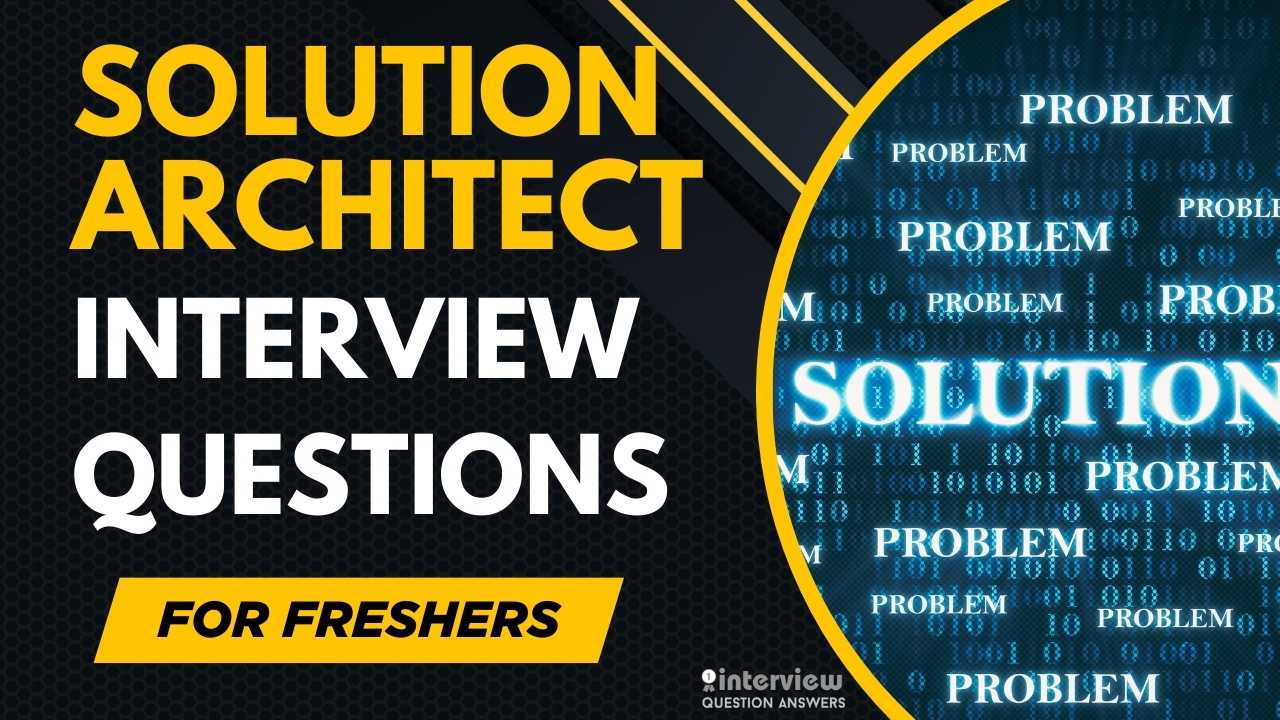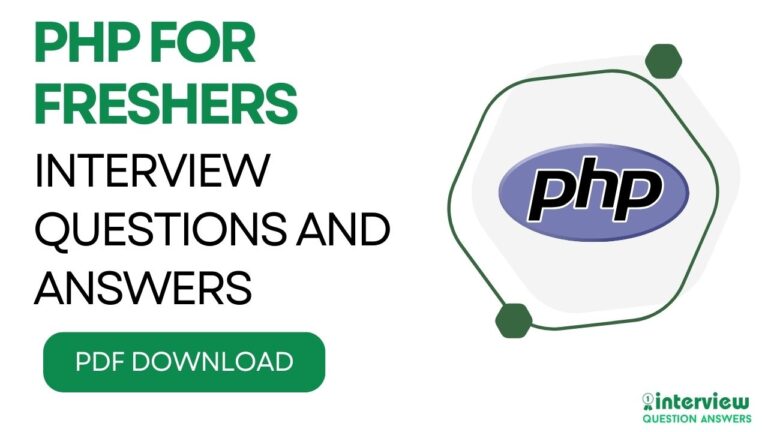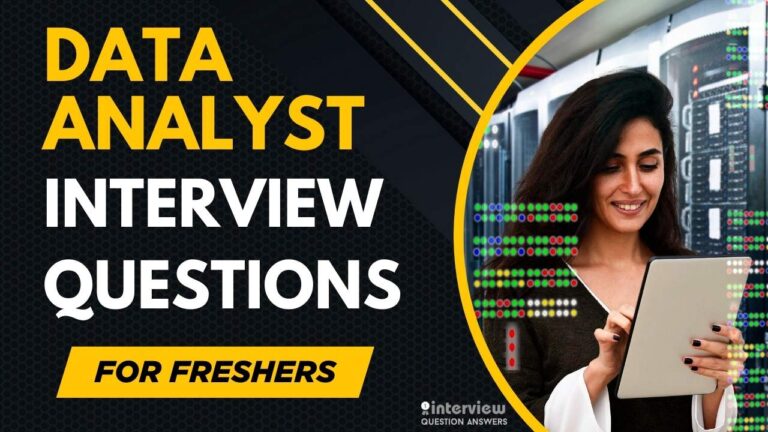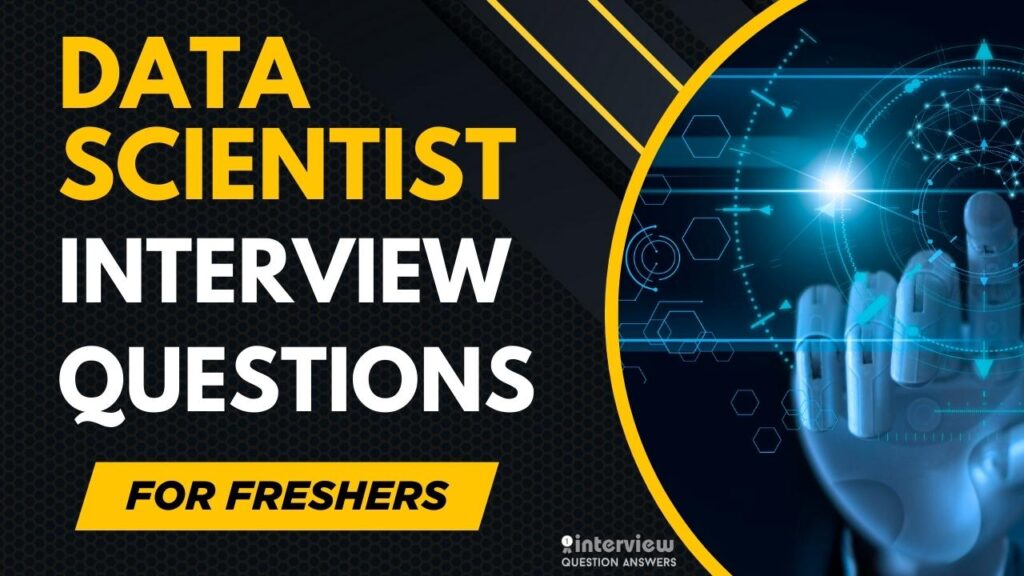Top Solution Architect Interview Questions for Freshers
This Solution Architect Interview Questions for Freshers guide provides you a carefully curated list of basic and beginner-friendly questions designed to help you understand the fundamental concepts of solution architecture and prepare confidently for interviews.
As businesses increasingly adopt cloud computing, microservices, and digital transformation technologies, freshers with knowledge of IT infrastructure, software development methodologies, and modern architecture practices have a strong advantage.
This guide helps you learn key areas of solution architecture such as system design fundamentals, software development life cycle (SDLC), cloud basics, database concepts, APIs, and integration techniques. It also introduces you to architecture principles, scalability, security basics, and problem-solving approaches that solution architects use to design effective and reliable systems.
You can also check: Solution Architect Interview Questions and Answers PDF
Table of Contents
Entry Level Solution Architect Interview Questions
Que 1. What is the role of a Solution Architect in a project?
Answer:
A Solution Architect designs and oversees the implementation of technology solutions, aligning them with business goals. They define system architecture, select technologies, and ensure scalability, performance, and security.
Que 2. What is the difference between a Solution Architect and a Technical Architect?
Answer:
A Solution Architect focuses on business needs, designing end-to-end solutions, while a Technical Architect dives deeper into technical details, focusing on system implementation and infrastructure.
Que 3. What are the key components of a system architecture diagram?
Answer:
Key components include frontend, backend, databases, APIs, load balancers, caching layers, and networking (e.g., VPCs). Tools like AWS Architecture Diagrams or Lucidchart are used to create them.
Que 4. How do you ensure a solution aligns with business requirements?
Answer:
Gather requirements through stakeholder interviews, create use cases, and validate designs with prototypes or POCs. Use frameworks like TOGAF to align solutions with business goals.
Que 5. What is cloud computing, and why is it important for solution architecture?
Answer:
Cloud computing delivers scalable, on-demand resources (e.g., AWS, Azure). It’s critical for Solution Architects to design cost-effective, flexible, and resilient systems using cloud services.
Que 6. What is the difference between IaaS, PaaS, and SaaS?
Answer:
- IaaS: Infrastructure like servers (e.g., AWS EC2).
- PaaS: Platforms for app development (e.g., Google App Engine).
- SaaS: Fully managed software (e.g., Salesforce).
Que 7. How do you choose between a monolithic and microservices architecture?
Answer:
Monoliths are simpler for small apps, while microservices offer scalability and modularity for complex systems. Consider team size, complexity, and deployment needs when deciding.
Que 8. What is a load balancer, and why is it used in solution architecture?
Answer:
A load balancer distributes traffic across servers to ensure availability and performance. For example, AWS ELB routes requests to healthy EC2 instances.
# AWS ELB configuration
LoadBalancer:
Type: AWS::ElasticLoadBalancingV2::LoadBalancer
Properties:
Subnets: [subnet-1, subnet-2]Que 9. What is scalability, and how do you design for it?
Answer:
Scalability ensures a system handles increased loads. Design with auto-scaling (e.g., AWS Auto Scaling), stateless components, and distributed databases like DynamoDB.
# AWS Auto Scaling
AutoScalingGroup:
Type: AWS::AutoScaling::AutoScalingGroup
Properties:
MinSize: 1
MaxSize: 5Que 10. What is the role of an API in a solution architecture?
Answer:
APIs enable communication between system components, such as microservices or third-party services. For example, REST APIs connect a frontend to a backend database.
// Express REST API
app.get('/users', (req, res) => {
res.json([{ id: 1, name: 'John' }]);
});Que 11. How do you ensure security in a cloud-based solution?
Answer:
Use encryption (e.g., AWS KMS), IAM roles, VPCs, and security groups. Implement WAF for web apps and monitor with tools like AWS CloudTrail.
{
"Effect": "Allow",
"Action": "s3:GetObject",
"Resource": "arn:aws:s3:::my-bucket/*"
}Que 12. What is a Virtual Private Cloud (VPC), and why is it important?
Answer:
A VPC is an isolated network in the cloud for secure resource deployment. It allows control over subnets, route tables, and security groups (e.g., AWS VPC).
# AWS VPC
VPC:
Type: AWS::EC2::VPC
Properties:
CidrBlock: 10.0.0.0/16Que 13. What is the purpose of a content delivery network (CDN) in a solution?
Answer:
A CDN (e.g., AWS CloudFront) caches content at edge locations to reduce latency and improve performance for global users.
# CloudFront distribution
Distribution:
Type: AWS::CloudFront::Distribution
Properties:
DistributionConfig:
Origins:
- DomainName: my-bucket.s3.amazonaws.comQue 14. How do you approach designing a cost-effective solution?
Answer:
Analyze requirements to avoid over-provisioning, use serverless or auto-scaling, and leverage cost tools like AWS Cost Explorer. Choose reserved instances for predictable workloads.
Que 15. What is a serverless architecture, and when would you use it?
Answer:
Serverless (e.g., AWS Lambda) runs code without managing servers, ideal for event-driven, low-maintenance apps like data processing or APIs.
// AWS Lambda
exports.handler = async (event) => {
return { statusCode: 200, body: JSON.stringify('Hello!') };
};Que 16. How do you ensure high availability in a solution?
Answer:
Deploy across multiple availability zones, use load balancers, and replicate data (e.g., AWS RDS Multi-AZ). Implement health checks and failover mechanisms.
# RDS Multi-AZ
DBInstance:
Type: AWS::RDS::DBInstance
Properties:
MultiAZ: trueQue 17. What is the role of monitoring in a solution architecture?
Answer:
Monitoring tracks system performance and issues using tools like AWS CloudWatch or Azure Monitor. It ensures reliability and proactive issue resolution.
# CloudWatch metric
aws cloudwatch put-metric-data --metric-name CPUUtilization --namespace MyApp --value 75Que 18. What is Infrastructure as Code (IaC), and why is it important?
Answer:
IaC manages infrastructure through code (e.g., AWS CloudFormation, Terraform), enabling automation, consistency, and version control.
# CloudFormation S3 bucket
Resources:
MyBucket:
Type: AWS::S3::Bucket
Properties:
BucketName: my-bucketQue 19. How do you handle data storage in a cloud solution?
Answer:
Choose storage based on use case: S3 for object storage, EBS for block storage, or RDS for relational databases. Ensure encryption and backups.
# S3 bucket
MyBucket:
Type: AWS::S3::Bucket
Properties:
BucketEncryption:
ServerSideEncryptionConfiguration:
- ServerSideEncryptionByDefault:
SSEAlgorithm: AES256Que 20. How do you document a solution architecture for stakeholders?
Answer:
Create architecture diagrams, technical specifications, and decision logs using tools like Lucidchart or Visio. Include components, data flow, and rationale for technology choices, ensuring clarity for technical and non-technical stakeholders.
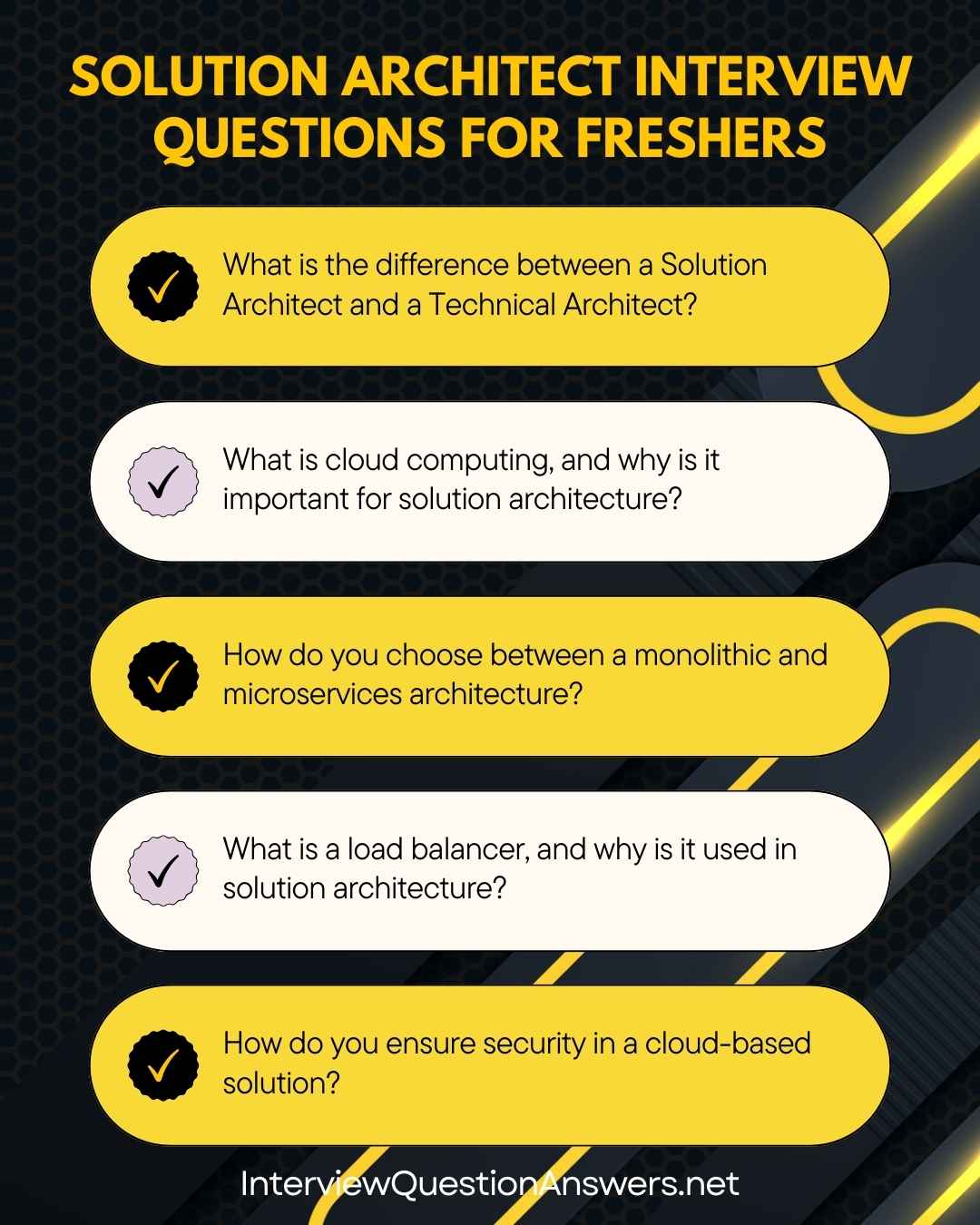
Also Check: Solution Architect Interview Questions for Experienced
Basic Solution Architect Interview Questions for beginners
Que 21. What is the purpose of a solution architecture document?
Answer:
A solution architecture document outlines the design of a system, including components, technologies, and data flow. It serves as a blueprint for developers and stakeholders, ensuring alignment with business goals.
Que 22. How do you gather requirements for a solution architecture?
Answer:
Engage stakeholders through interviews, workshops, and surveys to understand business needs, technical constraints, and user requirements. Document use cases and validate with stakeholders.
Que 23. What is the difference between a public cloud and a private cloud in solution design?
Answer:
A public cloud (e.g., AWS, Azure) is shared infrastructure managed by providers, offering scalability and cost-efficiency. A private cloud is dedicated to one organization, providing greater control and security.
Que 24. What is a load balancer, and why is it important in solution architecture?
Answer:
A load balancer distributes traffic across multiple servers to ensure availability and performance. For example, AWS Elastic Load Balancer (ELB) routes requests to healthy instances.
# AWS ELB configuration
LoadBalancer:
Type: AWS::ElasticLoadBalancingV2::LoadBalancer
Properties:
Subnets: [subnet-1, subnet-2]Que 25. How do you choose the right database for a solution?
Answer:
Select based on data type and use case: relational databases (e.g., AWS RDS) for structured data, NoSQL (e.g., DynamoDB) for unstructured data, or caching (e.g., Redis) for high-speed access.
Que 26. What is the role of a Virtual Private Cloud (VPC) in a cloud solution?
Answer:
A VPC provides an isolated network in the cloud, allowing control over subnets, security groups, and routing for secure resource deployment (e.g., AWS VPC).
# AWS VPC configuration
VPC:
Type: AWS::EC2::VPC
Properties:
CidrBlock: 10.0.0.0/16Que 27. What is scalability, and how do you design for it?
Answer:
Scalability ensures a system handles increased demand. Design with auto-scaling (e.g., AWS Auto Scaling), stateless applications, and distributed databases.
# AWS Auto Scaling
AutoScalingGroup:
Type: AWS::AutoScaling::AutoScalingGroup
Properties:
MinSize: 1
MaxSize: 5Que 28. How do you ensure a solution is cost-effective?
Answer:
Analyze requirements to avoid over-provisioning, use serverless services (e.g., AWS Lambda), and leverage cost tools like AWS Cost Explorer or Azure Cost Management.
Que 29. What is the purpose of a content delivery network (CDN) in a solution?
Answer:
A CDN (e.g., AWS CloudFront) caches content at edge locations to reduce latency and improve performance for global users.
# CloudFront distribution
Distribution:
Type: AWS::CloudFront::Distribution
Properties:
DistributionConfig:
Origins:
- DomainName: my-bucket.s3.amazonaws.comQue 30. What is serverless computing, and when would you use it?
Answer:
Serverless computing (e.g., AWS Lambda) runs code without managing servers, ideal for event-driven tasks like file processing or APIs due to automatic scaling and low maintenance.
# AWS Lambda function
exports.handler = async (event) => {
return { statusCode: 200, body: JSON.stringify('Hello!') };
};Que 31. How do you ensure security in a cloud-based solution?
Answer:
Use encryption (e.g., AWS KMS), IAM roles, security groups, and network ACLs. Monitor with tools like AWS CloudTrail to detect unauthorized access.
{
"Effect": "Allow",
"Action": "s3:GetObject",
"Resource": "arn:aws:s3:::my-bucket/*"
}Que 32. What is a microservices architecture, and what are its benefits?
Answer:
Microservices break an application into small, independent services communicating via APIs. Benefits include scalability, flexibility, and easier maintenance compared to monoliths.
Que 33. How do you design for high availability in a solution?
Answer:
Deploy across multiple availability zones, use load balancers, and replicate data (e.g., AWS RDS Multi-AZ) to ensure failover and uptime.
# RDS Multi-AZ
DBInstance:
Type: AWS::RDS::DBInstance
Properties:
MultiAZ: trueQue 34. What is Infrastructure as Code (IaC), and why is it useful?
Answer:
IaC defines infrastructure through code (e.g., AWS CloudFormation, Terraform), enabling automation, version control, and repeatable deployments.
# CloudFormation S3 bucket
Resources:
MyBucket:
Type: AWS::S3::Bucket
Properties:
BucketName: my-bucketQue 35. How do you select a cloud provider for a solution?
Answer:
Evaluate based on cost, services (e.g., compute, storage), compliance (e.g., GDPR), and global presence. Compare AWS, Azure, and GCP for specific needs like AI or serverless.
Que 36. What is the role of monitoring in a solution architecture?
Answer:
Monitoring ensures system health using tools like AWS CloudWatch or Azure Monitor to track metrics, logs, and set alerts for issues like high CPU usage.
# CloudWatch metric
aws cloudwatch put-metric-data --metric-name Latency --namespace MyApp --value 120Que 37. How do you handle data storage in a cloud solution?
Answer:
Choose based on use case: S3 for object storage, EBS for block storage, or RDS for relational data. Ensure encryption and backups for durability.
# S3 bucket with encryption
MyBucket:
Type: AWS::S3::Bucket
Properties:
BucketEncryption:
ServerSideEncryptionConfiguration:
- ServerSideEncryptionByDefault:
SSEAlgorithm: AES256Que 38. What is an API gateway, and how does it fit into a solution?
Answer:
An API gateway (e.g., AWS API Gateway) manages, secures, and routes API requests, enabling communication between services like microservices or serverless functions.
# API Gateway
RestApi:
Type: AWS::ApiGateway::RestApi
Properties:
Name: MyApiQue 39. How do you ensure a solution is maintainable?
Answer:
Use modular designs (e.g., microservices), document architecture, and implement IaC. Automate deployments with CI/CD pipelines and monitor with tools like CloudWatch.
Que 40. How do you communicate a solution architecture to non-technical stakeholders?
Answer:
Use simple diagrams (e.g., Lucidchart), avoid jargon, and focus on business benefits like cost savings or scalability. Provide high-level overviews and use analogies to explain technical concepts.
Advanced Solution Architect Interview Questions for Freshers
Que 41. How do you design a solution for high availability across multiple cloud regions?
Answer:
Design a multi-region architecture using services like AWS Route 53 for latency-based routing and data replication with S3 Cross-Region Replication or DynamoDB Global Tables. Implement load balancers and health checks to ensure failover, and monitor with CloudWatch for cross-region performance.
# Route 53 latency-based routing
HostedZone:
Type: AWS::Route53::RecordSet
Properties:
Type: A
LatencyRoutingPolicy:
Region: us-east-1
ResourceRecords: [my-app.us-east-1.amazonaws.com]Que 42. How do you ensure a solution is cost-optimized without compromising performance?
Answer:
Analyze usage with tools like AWS Cost Explorer or Azure Cost Management. Use serverless services (e.g., AWS Lambda), auto-scaling, and reserved instances for predictable workloads. Implement tagging for cost allocation and decommission unused resources.
# AWS CLI cost analysis
aws ce get-cost-and-usage --time-period Start=2025-09-01,End=2025-09-30 --granularity MONTHLYQue 43. How do you implement a serverless architecture in a solution design?
Answer:
Use AWS Lambda or Azure Functions for compute, API Gateway for routing, and serverless databases like Aurora Serverless. Orchestrate workflows with AWS Step Functions and monitor cold starts with CloudWatch.
# Step Functions state machine
StateMachine:
Type: AWS::StepFunctions::StateMachine
Properties:
DefinitionString: !Sub |
{
"StartAt": "Process",
"States": {
"Process": {
"Type": "Task",
"Resource": "${MyLambdaFunction.Arn}",
"End": true
}
}
}Que 44. How do you secure a cloud-based solution against common threats like DDoS?
Answer:
Use services like AWS Shield or Cloudflare for DDoS protection, implement WAF (Web Application Firewall), and encrypt data with KMS. Restrict access with IAM roles and monitor with CloudTrail.
# AWS WAF configuration
WebACL:
Type: AWS::WAFv2::WebACL
Properties:
Scope: REGIONAL
Rules:
- Name: BlockBadBots
Priority: 1
Statement:
ByteMatchStatement:
SearchString: "bad-bot"Que 45. How do you design a solution with microservices architecture?
Answer:
Break the application into independent services, deploy with containers (e.g., AWS ECS, Kubernetes), and use an API gateway for routing. Implement service discovery with Consul and monitor with Prometheus.
# ECS service
Service:
Type: AWS::ECS::Service
Properties:
Cluster: MyCluster
TaskDefinition: MyTask
DesiredCount: 3Que 46. How do you implement monitoring and observability in a cloud solution?
Answer:
Use tools like AWS CloudWatch, Azure Application Insights, or GCP Monitoring for metrics and logs. Implement distributed tracing with AWS X-Ray and set up alerts for proactive issue detection.
# CloudWatch Alarm
Alarm:
Type: AWS::CloudWatch::Alarm
Properties:
MetricName: CPUUtilization
Threshold: 80
AlarmActions: [sns-topic-arn]Que 47. How do you handle data migration to the cloud with minimal downtime?
Answer:
Use tools like AWS Database Migration Service (DMS) or Azure Data Factory. Plan incremental replication, validate schema compatibility, and test post-migration to ensure data integrity and minimal disruption.
# AWS DMS replication task
ReplicationTask:
Type: AWS::DMS::ReplicationTask
Properties:
SourceEndpointArn: !Ref SourceEndpoint
TargetEndpointArn: !Ref TargetEndpointQue 48. How do you ensure compliance with regulations like GDPR in a cloud solution?
Answer:
Implement encryption (e.g., AWS KMS), enforce data residency with region-specific deployments, and use compliance tools like AWS Config or Azure Policy. Conduct regular audits and anonymize sensitive data.
# AWS Config rule
ConfigRule:
Type: AWS::Config::ConfigRule
Properties:
Source:
Owner: AWS
SourceIdentifier: S3_BUCKET_SERVER_SIDE_ENCRYPTION_ENABLEDQue 49. How do you design a solution for real-time data processing?
Answer:
Use streaming services like AWS Kinesis or Azure Event Hubs to process real-time data. Trigger serverless functions (e.g., Lambda) for processing and store results in DynamoDB or BigQuery.
# Kinesis stream
Stream:
Type: AWS::Kinesis::Stream
Properties:
ShardCount: 2Que 50. How do you implement a CI/CD pipeline in a cloud-based solution?
Answer:
Use AWS CodePipeline, Azure DevOps, or GitHub Actions to automate testing, building, and deployment. Integrate with IaC tools like Terraform and deploy to ECS or Lambda.
# AWS CodePipeline
Pipeline:
Type: AWS::CodePipeline::Pipeline
Properties:
Stages:
- Name: Build
Actions:
- Name: BuildAction
ActionTypeId:
Category: Build
Provider: CodeBuildQue 51. How do you design a solution for multi-tenancy in the cloud?
Answer:
Isolate tenant data using separate schemas or databases (e.g., AWS RDS). Use IAM roles or VPCs for access control and monitor usage with CloudWatch for resource allocation.
# RDS for multi-tenancy
DBInstance:
Type: AWS::RDS::DBInstance
Properties:
DBName: tenant1
Engine: postgresQue 52. How do you optimize a cloud solution for low latency?
Answer:
Use edge computing (e.g., AWS Lambda@Edge), cache with CloudFront or Redis, and optimize database queries with indexing. Deploy to multiple regions and monitor with X-Ray.
// Lambda@Edge
exports.handler = async (event) => {
const request = event.Records[0].cf.request;
return request;
};Que 53. How do you manage secrets in a cloud-based solution?
Answer:
Use AWS Secrets Manager or Azure Key Vault for secure storage and rotation of secrets. Access via IAM roles and audit with CloudTrail to ensure security.
// AWS Secrets Manager
const AWS = require('aws-sdk');
const secretsManager = new AWS.SecretsManager();
const secret = await secretsManager.getSecretValue({ SecretId: 'my-secret' }).promise();Que 54. How do you handle disaster recovery in a cloud solution?
Answer:
Implement multi-region backups with AWS Backup or Azure Site Recovery. Use S3 Cross-Region Replication and test failover plans to ensure data availability.
# S3 Cross-Region Replication
ReplicationConfiguration:
Rules:
- Destination:
Bucket: arn:aws:s3:::destination-bucket
Status: EnabledQue 55. How do you integrate a cloud solution with on-premises systems?
Answer:
Use hybrid cloud solutions like AWS Direct Connect or Azure ExpressRoute for secure connectivity. Implement VPNs or API gateways for integration and ensure data consistency.
# AWS Direct Connect
Connection:
Type: AWS::DirectConnect::Connection
Properties:
Bandwidth: 1GbpsQue 56. How do you design a solution for event-driven architecture?
Answer:
Use services like AWS EventBridge or Azure Event Grid to trigger actions (e.g., Lambda functions) based on events like S3 uploads. Ensure idempotency and error handling.
# EventBridge rule
Rule:
Type: AWS::Events::Rule
Properties:
EventPattern:
source: ["aws.s3"]
Targets:
- Arn: !GetAtt MyLambdaFunction.ArnQue 57. How do you ensure a solution is scalable and elastic?
Answer:
Design with auto-scaling (e.g., AWS Auto Scaling), stateless applications, and distributed databases like DynamoDB. Use load balancers and monitor with CloudWatch for elasticity.
# AWS Auto Scaling
AutoScalingGroup:
Type: AWS::AutoScaling::AutoScalingGroup
Properties:
MinSize: 2
MaxSize: 10Que 58. How do you implement performance monitoring in a cloud solution?
Answer:
Use AWS CloudWatch, Azure Application Insights, or GCP Monitoring for metrics and logs. Implement distributed tracing with X-Ray and set up dashboards for real-time insights.
# X-Ray tracing
aws xray put-trace-segments --trace-segment-documents file://trace.jsonQue 59. How do you design a solution for a microservices-based API?
Answer:
Use an API gateway (e.g., AWS API Gateway) for routing, authentication, and rate limiting. Deploy microservices with ECS or Kubernetes and monitor with Prometheus.
# API Gateway
RestApi:
Type: AWS::ApiGateway::RestApi
Properties:
Name: MyApiQue 60. How do you document and communicate a complex solution architecture?
Answer:
Create detailed architecture diagrams with tools like Lucidchart, including components, data flows, and dependencies. Use decision logs and presentations to explain trade-offs to technical and non-technical stakeholders.
Conclusion
We have already shared the questions for Solution Architect Interview Questions for Freshers, covering basic architectural concepts, beginner-level scenario questions, and essential IT fundamentals to help you prepare effectively.
As IT architecture trends like cloud-native solutions, containerization, microservices, and AI-driven systems continue to evolve, freshers who stay updated on emerging technologies, security best practices, and performance optimization techniques will be well-prepared for future opportunities. This Solution Architect Interview Questions for Freshers Guide provides the foundation you need to understand how modern IT systems are designed, integrated, and managed.
Similar Interview Guides:

